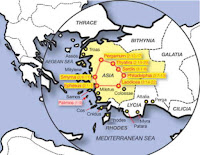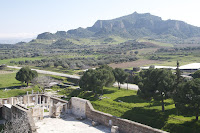Revelation 3:1-6: Letter to the Church in Sardis
 |
| Locations of the seven churches of Revelation chapters 2 and 3 |
Sardis was a city about 100 miles inland from Ephesus and Smyrna and 40 miles south of Thyatira. It had been occupied by the Persians for centuries, then taken by the Greeks, and later reconquered by the Persians. The city was finally captured by the Romans in 133 B.C. It was home to a significant Jewish community and by 100 A.D. had become an important center of Christianity.
Local
industries in Sardis included harvesting and dyeing wool and making clothing
and carpets for export and sale. There also was a thriving gold and silver
industry in Sardis. In the ninth century B.C., the craft workers at Sardis
minted the earliest-known gold and silver coins. Those precious metals were
obtained by sifting the sands at the bottom of the river that ran through the
city. The people referred to the sand in the riverbed as “golden sand.” By the
first century A.D. the gold production there was not so great as in the past,
and Sardis had become a city of little commercial significance, other than for
textiles produced there.
An
earthquake in 17 A.D. virtually destroyed the city, but the Romans rebuilt it.
Today, the site is the Turkish village of Sart, and the area is agricultural.
There are spectacular ruins on the site today, including a huge Roman bath and
gymnasium covering five acres, ruins of the temple of Diana, ruins of a large
synagogue, and the ruins of several other homes and shops.
The primary pagan worship in the province focused on the goddess Diana. One of the largest Roman temples to Diana in the world was located there. Sardis also is birthplace of the famous author Aesop.
 |
| The site of ancient Sardis in modern Turkey. |
 |
| Ruins of a pagan temple at the site of Sardis. |
Sardis is known in church history as the dead church. In his letter to the church, vv. 1-6, the Lord issues a stern reprimand:
“1 To the angel of the church in Sardis write: These are the words of him who holds the seven spirits of God and the seven stars. I know your deeds; you have a reputation of being alive, but you are dead. 2 Wake up! Strengthen what remains and is about to die, for I have found your deeds unfinished in the sight of my God. 3 Remember, therefore, what you have received and heard; hold it fast, and repent. But if you do not wake up, I will come like a thief, and you will not know at what time I will come to you. 4 Yet you have a few people in Sardis who have not soiled their clothes. They will walk with me, dressed in white, for they are worthy. 5 The one who is victorious will, like them, be dressed in white. I will never blot out the name of that person from the book of life, but will acknowledge that name before my Father and his angels. 6 Whoever has ears, let them hear what the Spirit says to the churches.”
What
do you think of when you hear the term “dead church”? What are the
characteristics of a dead church? We have a few clues from the text: “I know
your deeds; you have a reputation of being alive, but you are dead” (v. 1).
The church at Sardis had a good reputation in the community, due possibly
because of its works: caring for each other, ceremonial worship, helping the
poor, participation in civic affairs, generous giving to the church in
Jerusalem, or some other works. Jesus adds, however, “…but you are dead.”
The condition of this church was like that in the church at Ephesus. Historians
generally conclude that the church consisted largely of laxed or unsaved people,
who followed Jesus in name only, but whose lives conformed to the culture and
not to Christ.
We find more clues in vv. 2-3: “2 Wake
up! Strengthen what remains and is about to die, for I have found your deeds
unfinished in the sight of my God. 3 Remember,
therefore, what you have received and heard; hold it fast, and repent. But
if you do not wake up, I will come like a thief, and you will not know at what
time I will come to you.” He is telling them to take another look at what
they really are and make needed changes. The people needed to be saved. Their
doctrine was in error if the church condoned people who were Christians in name
only. The responsibility to know the spiritual condition of the people falls on
the pastor and church leaders. We are to lead them to understand their position
before Christ, lead them to faith in Christ, and lead them in growing
spiritually.
The
people also needed to hear doctrinal truth in preaching and teaching. The
phrase “…Wake up!…” (some translations: “Be watchful!”) in the
New Testament generally has to do with protecting and preserving doctrine and
truth. A watchman stood guard on the city wall, ready to sound the alarm at the
first sign of an enemy approaching.
“Strengthen
what remains and is about to die…” (v.2). Many in the church had held to the
faith, but it is possible they had just gotten lazy. Worship was merely
ceremony. Cultural norms were too influential compared to the norms of the
Christian faith. Perhaps they were emphasizing works over truth.
While
the church had a good reputation, it was not a light in the spiritual darkness
of the city of Sardis. We do not know details. Whatever was going on, they had
lost some intensity of their faith, and Jesus tells them, “Remember,
therefore, what you have received and heard; hold it fast, and repent” (v.
3). The Lord’s prescription for the cure is to return to the basics. The thrust
of Jesus’ statement in v. 3 is that “…what you received and heard…” evidently
was no longer the focus of the church. The focus needs to be on the gospel and
its impact in regeneration and living, the awesomeness of God, and the
excitement of daily knowing God better, spontaneous worship, and praise.
Jesus
tells them to repent of their current situation. “Repent” means to
change one’s mind and behavior. In other words, “stop doing what you are doing
and start doing what I told you to do.”
Jesus
refers to the condition in Sardis as soiling or defilement in v. 4: “Yet you
have a few people in Sardis who have not soiled their clothes. They will walk
with me, dressed in white, for they are worthy.” Indeed, a few people in
the church had held fast to His teachings. But the majority were “…soiled…”
(meaning “stained, contaminated, impure”; in fact, not really saved).
V. 5: “The one who is victorious will, like them, be dressed in white. I will never blot out the name of that person from the book of life, but will acknowledge that name before my Father and his angels.”
“The
one who is victorious…” can also translated “He who overcomes…” This is
a common phrase in the Bible that refers to Christians who remain true to their
faith despite temptations, persecutions, or even the threat of death. In the
context of this letter to the church in Sardis, v. 5 is an invitation for the
lost in the church to accept Christ and be saved.
An
alternate translation for “…will…be dressed in white…” in v. 5 could be “…shall
be clothed in white garments…”; that is, they shall stand holy and
blameless before God and receive the promised reward, which is an eternal
existence with Christ (“I will never blot out the name of that person from
the book of life…”). This is a typical affirmation for the Christian who
perseveres to the end, no matter the circumstances. The one who perseveres to
the end has given the sure evidence of his or her salvation and faith. The one
who turns from Christ—the one who does not persevere in the faith and turns
away—gives sure evidence that he or she has not been truly saved.
The
Prophetic View of this Letter
In
the prophetic view of the letters to the seven churches, the letter to Sardis
corresponds to a very dark time in history for Christianity. From the 11th to
16th centuries, the church did not preach the gospel of salvation by grace
through faith. Like Sardis, the church during that period had strayed from what
it had received and heard in the beginning. It was in a time characterized by
papal power and authority. The people were under the authority of the priests,
who answered to the bishops, who answered to the pope, the bishop of Rome.
During these centuries, it was church doctrine that salvation came through
submission to the church hierarchy and performance of rituals. This is in
contrast to “…Remember, therefore, what you have received and heard…”
(v. 3). What we have received is nothing less than salvation by grace through
faith.
The
church in the middle ages had taken authority over most civil affairs. Priests
and bishops were above everyone, and civil laws had no authority over them. To
enforce its authority, the church instituted the inquisitions, in which anyone
could bring to trial for expressing ideas contrary to church doctrine or
resisting the church’s line of authority, including ideas not only about
doctrine, but also about science, medicine, civil laws—anything, in fact, that
the church had an opinion about, and the church had an opinion about practically
every aspect of life.
Profession
of faith during this period was less a profession of actual belief in the
Savior and more a profession of allegiance to the church and its hierarchy.
Change
began early in the 16th century, however, with the posting of Martin
Luther’s “95 Theses” questioning many aspects of church doctrine and practice
and objecting to papal authority on matters such as the sale of indulgences and
banning copies of scripture from the people. Luther escaped torture and death
at the hands of the church’s inquisitors by going into hiding. The posting of
his theses criticizing the church started the protestant reformation and the
return of belief in the core Christian doctrine of salvation by grace through
faith.
Comments